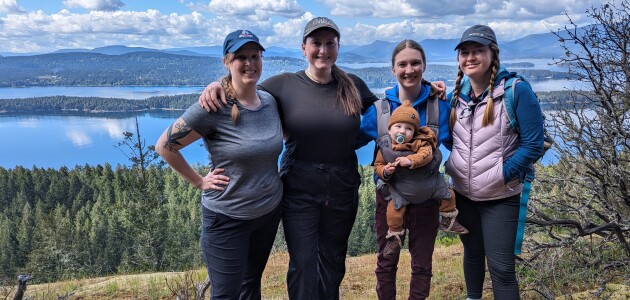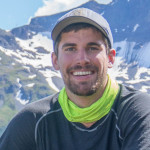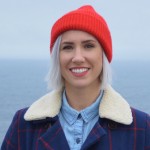We are pleased to announce the 2025 Liber Ero Fellows!
 Carrie Ann Adams
Carrie Ann Adams
Project: Protecting Canada’s migrating birds from habitat loss, artificial light attraction, and collisions using weather surveillance radar.
Primary Mentor Institutions: Carleton University (Christina Davy); Environment and Climate Change Canada (Gregory Mitchell); Kyle Horton (Purdue University); Birds Canada (Danielle Ethier); Safe wings (Willow English).
Summary: Every year, 2.5 billion birds migrate to Canada to breed, and we must protect both the terrestrial and aerial habitat on which they rely during migration. I am using weather surveillance radars (WSR) to detect birds taking off from their stopover areas and in migratory flight, identifying critical terrestrial and aerial habitats. I will work with Birds Canada and Environment Climate Change Canada to incorporate these radar-based maps into impact assessments and conservation plans. One of the greatest threats to migratory birds is artificial light, which disorients and attracts birds that migrate at night. I will use remotely sensed metrics of artificial light and the radar-based maps of bird migration to determine the attractive effects of light in the blue, green, and red wavelengths. My research will inform recommendations for light emitting diodes (LEDs) that reduce migratory bird attraction and collisions.
 William Bugg
William Bugg
Project: Drivers of Early Marine Mortality in Juvenile Pacific Salmon.
Primary Mentor Institutions: Pacific Salmon Foundation, Fisheries and Oceans Canada, University of British Columbia.
Summary: Interacting cumulative stressors limit the survival of juvenile salmon, leading to the drastic decline of many species and populations throughout British Columbia in recent decades. Throughout their early marine migrations salmon must overcome changing environments, food limitation, and pathogen exposure. Together these increase stress burdens, reduce energetic reserves, limit immune capacity and result in disease, ultimately resulting in high levels of mortality. However, as it is difficult to assess the physiological impacts of these stressors with traditional physiological methods, there is little scientific consensus on which factors and stressors pose the greatest risks for wild salmon. Together with my project partners, I will use cutting edge molecular techniques to assess stressor states, pathogen presence and abundance, and survival outcomes for individual Chinook salmon, to evaluate their roles as drivers of early marine mortality. Further, I will use the recent removal of salmon farms throughout the Discovery islands as a ‘natural experiment’ to evaluate the impacts of aquaculture on sockeye salmon pathogen and stress burden. With federal Chinook salmon rebuilding and aquaculture transition planning underway, this research is poised to provide key findings on cumulative stressor impacts at a critical point, and to help shape the future for the declining populations of wild salmon which are the backbone of ecosystems across the west coast.
 Spencer Greening
Spencer Greening
Project: Nii ‘Ntxo’ont’m (The Ones Who Feed Us): Indigenous Teachings on Ecosystems, Law, Stewardship, and Harvesting the Animals Who Feed Us.
Primary Mentor Institutions: University of Victoria (Dr. Darcy Lindberg and Dr. John Borrows), Gitga’at First Nation (Martin Ostrega), and the Wild Salmon Center (Dr. Will Atlas).
Summary: My postdoctoral research looks to the knowledge of my own people, that of the Gitga’at First Nation of the Pacific Northwest Coast, to showcase how Indigenous harvesting knowledge gives us essential insights into human and non-human ecological relationships. My work has two tangible research outcomes; first, a manuscript that highlights seven culturally important animal groups for the Gitga’at, each of which hosts a nuanced conversation on traditional harvesting, Indigenous law, ecological stewardship, and management in a modern context. These animal groups are salmon, halibut, mountain goat, bears, wolves, pinnipeds, and seabirds.
To compliment the knowledge presented in my manuscript, I am co-managing a community-based Gitga’at salmon weir project. Current research demonstrates how certain Indigenous fishing technologies, such as fish weirs, can benefit salmon populations while also acting as an innovative management tool. In this project we weave ecology, decolonization, and harvesting by rebuilding a modern, yet traditional style, salmon weir, to reclaim Gitga’at salmon fishing methods that have been disrupted by industry and federal fisheries mismanagement. By pairing ancestral knowledge with modern science, our goal is to re-examine the future of Indigenous fisheries co-management, data collection, and sustenance fishing. Ultimately these conversations will provide lessons for all people who wish to live in a more ecologically conscious society.
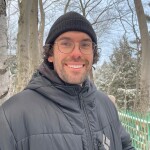 Benjamin Larue
Benjamin Larue
Project: Crossings in a changing Arctic — Mitigating the adverse effects of roads on barren-ground caribou.
Primary Mentor Institutions: Université Laval and Caribou Ungava (Dr. Steeve D. Côté), SUNY College of Environmental Science and Forestry (Dr. Eliezer Gurarie), Wildlife Division, Environment and Natural Resources, Government of Northwest Territories (Dr. Jan Adamczewski), and World Wildlife Fund (Dr. Brandon Laforest).
Summary: Once numbering over 800,000, the George River caribou herd in Nunavik has dwindled to fewer than 8,000—an alarming >99% decline in just a few decades. The Bathurst herd in Nunavut/Northwest Territories faces a similarly dire future, and many other migratory herds across the Canadian Arctic are in rapid decline. For Indigenous communities, these losses bring food insecurity, cultural erosion, and the loss of vital traditions.
A significant but often overlooked threat to barren-ground caribou is road development. Roads can slice through migration corridors, disrupt movement, and increase vulnerability to poaching and disturbance. With major projects like the 230 km Grays Bay Road on the horizon—intersecting the migrations of three herds—there’s an urgent need to address these threats before further damage is done.
My Liber Ero project unites Indigenous communities, government agencies, NGOs, and academics to find solutions. The project has two goals: 1) to identify strategies for reducing the impacts of existing and planned roads in the Canadian Arctic, and 2) to develop a simulation tool for proactive, data-driven management. This tool will enable decision-makers to visualize how infrastructure projects could affect caribou movement and Indigenous access to resources, guiding road placement, design, traffic regulation, and seasonal closures. Ultimately, this project will inform better policies that support both caribou and the communities that depend on them.
2024 Liber Ero Fellows
 Sara Cannon
Sara Cannon
Project: Towards social justice and sustainability in Canadian salmon fisheries: industrial transboundary fisheries and Indigenous rights
Primary Mentor Institutions: University of British Columbia (Dr. Andrea Reid), Simon Fraser University (Dr. Jon Moore), First Nations Fisheries Council (Janson Wong), and the Wild Salmon Center (Dr. Will Atlas)
Summary: Policy and regulation of Pacific salmon fisheries is complicated by their migratory routes, which often cross international borders. The Pacific Salmon Commission, a joint US-Canada body, oversees salmon fisheries in the Pacific Northwest under the Pacific Salmon Treaty. The Treaty will be renegotiated in 2028, offering an opportunity to address gaps in international management.
For my Liber Ero project, I will develop a comprehensive overview of the threats that transboundary marine mixed-stock fisheries pose to sockeye and Chinook salmon that spawn in BC and the Yukon. By combining existing fisheries landings and run reconstruction data, I will estimate the number of salmon currently lost to harvesting and the reduction in harvest required to meet conservation objectives. At the same time, I will identify the First Nations whose territories host these salmon runs and invite their participation in the research.
The project contributes to the ongoing review of the Salmon Allocation Policy and underscores the need to recognize Indigenous fisheries rights along entire migratory routes. The findings have the potential to drive transformative changes in fisheries management at provincial, federal, and international levels, safeguarding the future of Pacific salmon and the communities that depend on them.
 Jayme Lewthwaite
Jayme Lewthwaite
Project: Building a framework to harness community science and multispecies occupancy modelling to improve species-at-risk prioritization and assessment in Canada
Primary Mentor Institutions: Carleton University (Dr. Rachel Buxton), University of Southern California (Dr. Laura Melissa Guzman), Committee on the Status of Endangered Wildlife in Canada (John Klymko and Jennifer Heron), NatureServe Canada (Patrick Henry and Jacqueline Clare).
Summary: There is now ample evidence that many insect populations are rapidly declining. We need to take immediate action to protect them. For a species at risk of extinction to receive legal protection in Canada, it must first be assessed by COSEWIC (the Committee on the Status of Endangered Wildlife in Canada). Assessment decisions require data on species populations and geographic distributions.
There are a number of challenges that COSEWIC faces in assessing understudied groups like insects. First is a serious capacity limitation: there are an estimated 55,000 species of insects in Canada, but currently COSEWIC can only assess a handful of them per year. Second, there is a lack of long-term monitoring data. However, the rise of community-science data, such as from iNaturalist, is rapidly generating valuable information that could be invaluable in documenting insect declines.
My Liber Ero project will harness community-science data in a multi-species occupancy modelling approach to inform the COSEWIC prioritization and assessment process by generating: (i) maps of current and historical distributions, (ii) trends in occurrence, and (iii) estimates of the impact of threats (such as climate change) on species’ distributions. I will focus primarily on insects, but will co-develop user-friendly tools and analysis pipelines so that COSEWIC can apply these approaches more broadly during the listing process, such with other understudied taxonomic groups.
Ultimately, my aim is to make the most of existing data and limited capacity to optimize the listing and protection of imperiled species.
 Mary Ann Perron
Mary Ann Perron
Project: Multidecadal tracking of changes in wetland cover to support conservation across complex jurisdictional boundaries along Kaniatarowanenneh (the St. Lawrence River)
Primary Mentor Institutions: St. Lawrence River Institute of Environmental Sciences (Dr. Leigh McGaughey), Aronia Collective (Abraham Francis), Nipissing University (Dr. John Kovacs).
Summary: Wetland ecosystems are among the most important ecosystems for species conservation but have experienced some of the highest rates of degradation and destruction. While the degradation of wetlands in the Great Lakes is relatively well documented, less is known about the wetlands of the Upper St. Lawrence River, which spans Ontario, Quebec, New York State and First Nations Reserve Lands.
My project aims to determine the extent of wetland cover change in this large, urbanized watershed and to provide insights into the efficacy of wetland conservation across different jurisdictions. I will also develop methodologies for watershed-based management and help inform wetland-related policy in Canada. The work will follow the Haudenosaunee principles of Two Row Wampum, which provide a framework for working together while also respecting individuality and autonomy.
The project will contribute to the Great River Rapport, a collaborative, community-engaged ecosystem health report for the Upper St. Lawrence River. Launched in 2018 as a partnership between the River Institute and the Mohawk Council of Akwesasne, the Great River Rapport works with partners and collaborators to identify regional patterns, trends, and data gaps for 35 indicators of ecological health. Engaging art, design, and storytelling, the project aims to inspire action, empower communities through increased access to information, and connect people with local ecosystems and each other.
 Morgan Piczak
Morgan Piczak
Project: Atlantic mackerel collapse: Examining spatial ecology in support of stock recovery
Primary Mentor Institutions: Dalhousie University (Dr. Robert Lennox) and Fisheries and Oceans Canada (Dr. Elisabeth Van Beveren).
Summary: Atlantic mackerel populations in eastern Canada recently experienced extensive declines attributed to overfishing and potential impacts associated with global climate change. These declines resulted in an unprecedented closure of the fishery. Atlantic mackerel form the foundation of the pelagic food web and support commercial, bait, recreational, and Indigenous fisheries. Best practices in fisheries management center on evidence-based decision-making; however, there are substantial gaps in our knowledge regarding mackerel spatial ecology and survival.
For my Liber Ero Fellowship, I will address these data gaps using acoustic telemetry in collaboration with the Ocean Tracking Network. We will identify spawning and migration routes, as well as associated environmental drivers. Better identification of these areas would inform management strategies, such as seasonal closures, aimed at increasing recruitment. We will also estimate natural mortality by quantifying survival of tagged individuals to generate more accurate estimates of spawning stock biomass. Together, this project aims to generate knowledge that will support the sustainable recovery of Atlantic mackerel.
2023 Liber Ero Fellows
 Zoie Diana
Zoie Diana
Project: Paint microplastics in the St. Lawrence Seaway
Primary Mentor Institutions: University of Toronto (Dr. Chelsea Rochman), Ontario Ministry of the Environment, Conservation and Parks (Dr. Paul Helm), and Ocean Conservancy (Nicholas Mallos).
Summary: Plastic debris, including microplastics (particles less than 5 millimeters), is a growing class of environmental pollutants. Recent research suggests that paints are an underestimated source of microplastic pollution. As a Liber Ero, I will further our understanding of this potentially important source of microplastics – both in terms of the extent of contamination in the environment and effects on the natural world.
My primary objectives are to 1) quantify paint microplastic pollution in surface waters and sediments of the St. Lawrence Seaway; 2) characterize the ecological effects of the top three coating-related microplastics using the benthic worm Tubifex tubifex as a surrogate; and 3) develop a network of practitioners to facilitate cross-sector and regional cooperation around paints as a source of microplastics.
The St. Lawrence Seaway is an essential conduit for the North American economy, a globally important shipping lane, and adjacent to major urban areas in Canada, including Toronto, Montreal, and Québec City. Due to its density, paint microplastics are likely to sink and contaminate sediments and accumulate in benthic organisms, like T. tubifex. As such, I will measure endpoints relevant to the organismal and population levels of biological organization: percent survival (acute and chronic), hatching rate of cocoons, number of cocoons produced per adult worm, and number of offspring per adult worm. This worm is widespread in freshwater ecosystems, an indicator of ecosystem health, and an important prey item for aquatic insects, crustaceans, and fish. Beyond insights into the contamination and ecological effects of paint microplastics in aquatic ecosystems, this research will convene stakeholders across sectors to discuss the state of the science on paint microplastic pollution, develop a shared research agenda, build collaborations, and have shared conversations about the impacts and paths forward. This research will be used to inform water quality monitoring and environmental management/policy in Canada. Project website: https://uofttrashteam.ca/paint/
 Mark Louie Lopez
Mark Louie Lopez
Project: Reconstructing the history of long-term human-mediated ecosystem changes in the Oil Sands Region: Integrating environmental DNA (eDNA) tools in Indigenous-led ecosystem monitoring
Primary mentor institutions: University of Victoria (Dr. Caren C. Helbing), Environment and Climate Change Canada (Dr. Mark E. McMaster), University of Calgary (Dr. Paul Drevnick), Chipewyan Prairie Dene First Nation (Dr. Ave Dersch and Chris Heavy Shield), Cold Lake First Nation (Findlay MacDermid), and Hakai Institute (Dr. Matt Lemay and Chris Hebda).
Summary: The oil sands industrial activities (OSIA) in northeastern Alberta are expected to influence surrounding freshwater bodies (e.g., lakes, wetlands, and rivers). With this, monitoring programs have been established to assess the impacts of oil sands development to inform regulatory decisions and ensure that OSIAs were being developed responsibly. However, with limited baseline data and lacking historical reference points, it is extremely difficult to evaluate the current state and anthropogenic impacts of lake ecosystems. Sedimentary DNA (sedDNA), a type of environmental DNA that has been deposited and retained in lake sediments over extended periods, can be a useful proxy in reconstructing the long-term dynamics of ecosystem features by bridging crucial information gaps in temporal ecology. Moreover, First Nation communities in the oil sands region hold detailed Indigenous knowledge (IK) about the historical land use and fisheries data in lakes within their territories that predates the advent of oil sands activities in the region. The integration of IK with western science, like sedDNA-inferred diversity analysis, can help reveal information about the history of long-term human-mediated ecosystem changes within Indigenous territories.
My project aims to document the long-term human-mediated ecosystem changes in lakes affected by OSIA and initiate an eDNA-based Indigenous-led ecosystem monitoring with the Chipewyan Prairie Dene and Cold Lake First Nations. Through extensive applied collaborative research networks and the application of novel methodologies, we hope to accomplish the following goals: (i) profile the temporal trends in nutrient and heavy metal loads of selected lakes; (ii) reconstruct the time series shifts in plankton, macroinvertebrates, and fish community structure to identify bioindicator species that are sensitive to human-mediated changes; and (iii) develop standardizable quantitative PCR (qPCR)-based eDNA tools and provide training. Establishing ecological monitoring programs that rely on strong eDNA tools empowers our First Nation partners to have timely and pertinent information on the impacts of Oil Sands activities within their territories.
 Melanie Massey
Melanie Massey
Project: Pets, Ponds, and Present Populations: An Integrative and Comparative Approach to Mitigating the Impact of Invasive Goldfish
Primary Mentor Institutions: University of Toronto, Scarborough Campus (Dr. Nicholas Mandrak), The Royal Botanical Gardens (Dr. David Galbraith), and the Invasive Species Centre (Colin Cassin).
Summary: There is rising concern from both scientists and the public over the ongoing invasion of Goldfish (Carassius auratus) in Ontario’s freshwaters, including both Lake Ontario and stormwater ponds across the province. Although we know that Goldfish (and related carp species) can be extremely destructive invaders, we have almost no foundational scientific information on the spread and impacts of invasive Goldfish in Ontario. For my Liber Ero project, I’ll take an integrative approach combining both ecophysiology and community outreach to assess and mitigate the risks of invasive Goldfish in Ontario.
I will examine whether climate change-related environmental factors explain recent increases in Goldfish abundance and assess their potential impacts under current and climate change projections. I’ll take a comparative approach that contrasts the ecophysiology of different populations of Goldfish (domestic Pets, stormwater Pond-caught, and those Present in Lake Ontario) with a close relative, the Common Carp. This approach will allow us to identify if certain Goldfish populations pose a greater threat to Ontario’s freshwaters under climate change conditions, while also allowing us to make clear recommendations on the need for Goldfish management through comparison with a similar but heavily managed carp species.
Because many invasive Goldfish in Ontario are descended from pet trade lines through abandonment of unwanted pets, a key component of my project will be to mitigate the risk of anthropogenic spread through community outreach. For this part of my project, I will be developing and delivering interactive and educational programming to the community on Goldfish as aquatic invasive species.
 Courtney Robichaud
Courtney Robichaud
Project: Developing community-based watershed monitoring in the Great Lakes
Primary mentorship Institutions: Carleton University (Dr. Joseph Bennett), Healthy Headwaters Lab at University of Windsor (Dr. Catherine Febria), and Ode’imin Indigenous Knowledge Circle (Candy Donaldson).
Summary: The land now called Canada is home to almost a quarter of the remaining wetlands in the world. Despite their ecological, cultural, and spiritual importance, wetlands are destroyed disproportionately more than other ecosystem types. In southern Ontario, only 11% of marshes from pre-European settlement remain. Ecological restoration provides an opportunity to repair relationships with the land, water and people, resulting in impactful and meaningful conservation work.
As a Liber Ero Fellow, I am working with my mentorship team to support local First Nation partners who are developing a community-based watershed monitoring program, with a focus on wetland restoration and carbon monitoring. This work will weave western science approaches with community-led priorities, building community capacity in all aspects of co-creation, training and mentorship, data collection, analysis, and interpretation.
By walking together, we will strengthen local First Nations communities of practice and be one example of how authentic place- and trust-based partnerships can contribute to the improved health of Nayaano-nibiimaang Gichigamin (The Great Lakes basin).
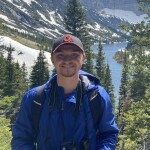 Peter Thompson
Peter Thompson
Project: Linking southern resident killer whale space use to vessel-based disturbance in the Salish Sea
Primary mentor institutions: Simon Fraser University (Dr. Ruth Joy), Dalhousie University (Dr. Michael Dowd), and Department of Fisheries and Oceans (Dr. Harald Yurk).
Summary: The southern resident killer whale (SRKW) population currently contains 73 individuals distributed across three pods (J, K, and L), of which less than 60% are reproductive. The population faces a high risk of extinction and losing a single reproductive animal could have population consequences. Numerous anthropogenic pressures, including limited prey availability, acoustic and physical disturbance from vessels, and contamination, threaten the recovery of the population. SRKW pods spend much of their time in the Salish Sea and adjacent marine regions, in which they encounter large commercial vessels regularly due to traffic in to and away from major ports in Vancouver and Seattle. However, the way these interactions impact marine space use on a longer temporal scale is presently unknown. Marine animals such as SRKWs are difficult to track for long periods of time, so many traditional statistical approaches are not sufficient for identifying the drivers behind the whales’ movements.
As a Liber Ero fellow I will design mechanistic movement models to describe the disturbance risks and behavioural responses of these endangered whales in the Salish Sea. I will incorporate a diversity of data sources characterizing the spatiotemporal distribution of whales and their co-occurrence with anthropogenic activities in the region to identify important factors that are linked to SRKW movement.
Our framework will allow for prediction of how SRKW movement and space use will be affected by vessel regulations and other human use changes. I hope that developing and applying this framework to the SRKWs, a culturally iconic species in the Northeast Pacific, will represent an important step in facilitating science-informed coexistence between humans and wildlife.
2022 Liber Ero Fellows
 Allyson Menzies
Allyson Menzies
Project: Prioritizing Indigenous Values in Environmental Monitoring and Wildlife Conservation
Primary mentor institutions: University of Guelph (Dr. Jesse Popp) and Nature United (Amanda Karst)
Summary: A major barrier to widespread implementation of decolonized approaches to environmental conservation is a general uncertainty of how to do so; while a number of frameworks describe how to work across cultures in theory (e.g., Two-Eyed Seeing, Two-Row Wampum), very few resources outline how to achieve this in practice. Generating practical resources, frameworks, and case studies that detail the tools, methodologies, and approaches that have been successful have the potential to inspire and guide future environmental initiatives that aim to weave knowledge systems to better observe, understand, and care for the environment. Finding ways to bridge knowledge systems in conservation is particularly important for species, like moose (Alces alces), that provide food, recreation, tools, clothing, art, and ceremony for Indigenous Peoples around the globe.
My project has three distinct components that will simultaneously work towards my overarching objective of decolonizing environmental monitoring and wildlife management. I will:
- Summarize Western scientific and Indigenous perspectives on “best practices” related to building environmental monitoring and research programs that better embrace Indigenous worldviews and community priorities
- Apply insights from Objective #1 to support the design and implementation of Indigenous-led moose monitoring programs in Manitoba and northern Ontario, providing tangible case studies of weaving knowledge systems in practice in the context of a culturally important species
- Develop an important, ethical, online space called Weaving Ways of Knowing for the Environment that will serve as a repository for resources and case studies of integrative environmental initiatives in order to facilitate knowledge dissemination, capacity building, and networking among environmental professionals at regional, provincial, and national scales.
In accomplishing these objectives, we hope to generate data, online resources, and tangible case studies that exemplify a more holistic approach to wildlife monitoring that recognizes the role and strengths of both Indigenous Knowledge and Western Science in conservation, acknowledges Indigenous Peoples’ rights and authority to care for their traditional territories, and creates space for Indigenous voices in critical discourse related to environmental conservation.
 Michael Price
Michael Price
Project: Shifting Salmon Distribution in Response to Climate and Land-use Change
Primary mentor institutions: Simon Fraser University (Dr. Jonathan Moore), Office of the Gitanyow Hereditary Chiefs (Tara Marsden, Joel Starlund), SkeenaWild Conservation Trust (Greg Knox)
Summary: Climate warming and human land uses are altering the suitability of habitats for societally-important species. Indeed, species are rapidly shifting their ranges in latitude and elevation as they try to keep pace with climate change. These shifts are impacting Indigenous Peoples, and their deep expertise is revealing how complex ecosystems are changing in diverse ways. Historic habitat protections that were established to ensure the persistence of important species may not keep pace with such rapid change. Similarly, currently unprotected and largely unrecognized habitat may host these species in the future. Thus, there is an urgent need for forward-looking science that partners with local communities to understand ecosystem change, which can then collaboratively inform land-use plans to effectively protect important species of concern.
My project will use an array of scientific tools and partnerships to identify and protect future climate refuge habitat for salmon. Specifically, I will document the response of salmon habitat and populations to land-use development and climate change with the aim of understanding – and proactively protecting – habitat that is currently unoccupied by salmon which may host these fish in the future. To achieve this, I will use two broad approaches: 1) fish scales collected from salmon over the last century to document the spatial shift in spawning distribution of populations across habitats, and 2) quantification of changes in salmon habitat in response to glacier retreat and land-use development associated with industrial logging, which I will link with the observed shifts in salmon spawning distribution over time. Lessons learned will be shared with Indigenous communities to help them protect areas that are identified as potential future refuges for salmon in their respective territories.
 René Shahmohamadloo
René Shahmohamadloo
Project: Genomic tools to manage harmful algal blooms in the Great Lakes
Primary mentor institutions: University of Guelph (Dr. John M. Fryxell), Washington State University (Dr. Seth M. Rudman), Environment and Climate Change Canada (Dr. Arthur Zastepa), Ontario Ministry of the Environment, Conservation and Parks (Dr. Satyendra P. Bhavsar)
Summary: Harmful algal blooms of the cyanobacterium Microcystis are a major threat to freshwater biodiversity and ecosystem function. Finding new management strategies to compliment reductions in phosphorous loading is essential to conserving temperate freshwater ecosystems. Meeting this need for new management strategies is complicated by a limited understanding of several fundamental aspects of the ecology of Microcystis. Ecological genomics has revealed considerable intraspecific variation, including in key functional traits related to nutrient uptake and toxin production. Combinations of these fitness traits can lead to considerable differences in phenotypes, and this intraspecific variation may be key to understanding, and ultimately predicting, the formation, severity, and toxicity of harmful algal blooms.
My Liber Ero Fellowship centres on developing and deploying a genetic screening tool for monitoring clonal variation in Microcystis that is reliable in the field, rapid, and low-cost. This method leverages extensive whole-genome sequencing of Microcystis clones from Lake Erie to generate a highly multiplexed targeted single nucleotide polymorphism (SNP) amplicon sequencing protocol. The SNPs selected provide both the resolution to distinguish between previously identified clades with notably different traits, including loci with large effects on toxin and secondary metabolite production and growth rate. Through a series of laboratory and field experiments, my collaborators and I will help answer the following questions: 1) Which Microcystis strains are present in particular locations of the Great Lakes? 2) At what times of the year and in which locations do they dominate? and 3) What are the key functional traits that could impact Great Lakes ecosystems? Insights generated from these inquiries will be a major contribution to the understanding of the biological mechanisms driving the frequency, severity, and toxicity of harmful algal blooms. In turn, this will propel us forward in our commitment to create new management strategies that will protect wildlife and humans.
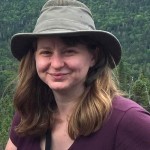 Karen Vanderwolf
Karen Vanderwolf
Project: Bat Conservation in Canada: are bat boxes quality roosting habitat?
Primary mentor institutions: University of Waterloo (Dr. Liam McGuire), Canadian Wildlife Federation (James Page), Wildlife Conservation Society Canada (Dr. Cori Lausen)
Summary: Bats in Canada face multiple and cumulative threats including habitat loss/degradation and disease such as white-nose syndrome. Bat boxes are used to encourage bat roosting for various purposes including wildlife viewing, insect pest control, and as mitigation for habitat loss such as evictions from anthropogenic roosts. However, our preliminary results indicate that only ~20% of bat boxes in Canada are used by bats. Factors resulting in successful use of this type of artificial habitat supplementation are often not clear, particularly in Canada where little research has been done, especially on a national scale.
Potentially important factors influencing bat box occupancy include placement, physical characteristics, and internal microclimate. For example, unused bat boxes may be too hot or too cold. Mortality, especially of pups, has been observed when bat boxes are too hot, but the prevalence of these events is unknown.
My study is a national community science project designed to determine the types of bat boxes used by bats in Canada, particularly those used by maternity colonies. Data collected by community scientists will document physical characteristics of boxes, usage, microclimate, and presence of the fungus that causes white-nose syndrome. My research will inform the public and policy makers about best practices for the use of artificial roosting habitat for different species of bats in Canada.
2021 Liber Ero Fellows
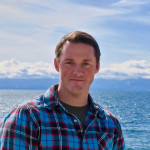 Kieran Cox
Kieran Cox
Project: Sound Marine Management: Integrating Marine Bioacoustics into Habitat Protection, Spatial Planning, and Policy
Primary mentor institutions:Simon Fraser University (Dr. Isabelle Côté), World Wildlife Fund Canada (Hussein Alidina), Hakai Institute (Dr. Margot Hessing-Lewis), Fisheries and Oceans Canada (Dr. Dana Haggarty and Dr. Sarah Dudas), Cornell University Center for Conservation Bioacoustics (Dr. Aaron Rice), University of Victoria (Dr. Natalie Ban and Dr. Francis Juanes)
Summary: Marine noise pollution is now ubiquitous along British Columbia’s coastal line. The species that reside within these ecosystems contend with the direct and indirect effects of anthropogenically modified soundscapes. The release of this pollution and the ecological effects it elicits occur unimpeded, as no comprehensive federal or provincial laws regulate ocean noise in British Columbia. This issue is of national concern as the prevalence and severity of marine noise pollution are projected to increase rapidly and expand further into northern British Columbia due to approved resource projects and expanding coastal developments. The unregulated noise pollution released as a byproduct of these activities will occur despite opposition led by coastal First Nations and non-government organizations.
My Liber Ero Fellowship will apply a three-tiered approach to integrating bioacoustics into the conservation of BC’s marine ecosystems. The three tiers of this project, species-habitat interactions, spatial planning, and policy, will be conducted in collaboration with academic collaborators Dr. Isabelle Côté, Dr. Natalie Ban, Dr. Aaron Rice, and Dr. Francis Juanes, and conservation practitioners Hussein Alidina of the World Wildlife Fund Canada, Dr. Margot Hessing-Lewis of the Hakai Institute, and Dr. Dana Haggarty and Dr. Sarah Dudas of Fisheries and Oceans Canada. Together we will identify the ecological implications of anthropogenically modified marine soundscapes and construct an evidence-based framework for mitigating the impacts of this pollutant.
 Laura Melissa Guzman
Laura Melissa Guzman
Project: Identifying conservation policies for insects and pollinators at continental and regional scales using decision theory, occupancy modeling and community science
Primary mentor institutions: Simon Fraser University (Leithen M’Gonigle, Elizabeth Elle), Pollination Partnership Canada (Lora Morandin)
Summary: Insects are the most diverse animals on the planet. In addition to being an integral part of virtually every terrestrial ecosystem, they provide numerous ecosystem services, such as pollination and decomposition, that have tremendous value to humans. Unfortunately, we have observed population declines of many insect species. Habitat loss, pesticide use and climate change are some of the major drivers of insect decline. However, we do not know which insect species are affected the most, and how drivers differ in their species effects.
For my Liber Ero fellowship I propose to use museum collection records, large scale databases and citizen science records to determine where most insects are experiencing greatest decline in North America. I also want to determine which driver (pesticide use, climate change or habitat loss) is causing the most decline of the most species of insects. I can then use this information to decide where we can target our conservation efforts for insects, and which methods would be most effective in different regions (i.e. habitat restoration or reduction of pesticide use). I also want to do a parallel study involving pollinators of the Pacific Northwest, where we have detailed researcher surveys of pollinators and citizen science records. This smaller scale analysis will allow me to provide targeted solutions for Pollinator Partnership Canada, an NGO dedicated to the conservation of pollinators. My research will provide actionable policy prescriptions to improve the distribution of insects and pollinators.
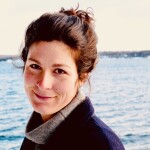 Laurenne Schiller
Laurenne Schiller
Project: Scaling past marine conservation successes in Canada to address current and future challenges
Primary mentor institutions: Carleton University (Drs. Graeme Auld & Steven Cooke), Ocean Wise Seafood (Sophika Kostyniuk), Oceana Canada (Dr. Robert Rangeley) & Organic Ocean (Guy Dean)
Summary: Canada is an ocean nation. We have the world’s longest coastline and one-third of our country’s total area is covered by the marine environment. The federal government has also positioned Canada as a global leader in marine conservation, recently committing to protect 30% of Canadian waters and sustainably manage all commercial fisheries by 2025. However, substantial problems and barriers persist in the implementation of effective marine conservation measures to meet these ambitious goals. My research will analyze past marine conservation successes and failures to provide science-based advice on how to enable more positive conservation outcomes in Canada.
Throughout this work I will focus on the catalytic contributions of environmental NGOs, fishery co-operatives, seafood businesses, citizens, and Indigenous rightsholders. Working with diverse mentors offering deep experience and understanding of marine policy in Canada and its impacts on different user groups, I will compile and analyze a series of qualitative and quantitative databases to understand what helps and hinders marine conservation successes. Ultimately, I seek to understand how lessons learned from past successes can be leveraged to rebuild depleted fisheries, protect vulnerable species, and restore marine habitats along our coasts. I hope to provide an evidence-based roadmap to enable more productive relationships between stakeholders and rightsholders as Canada strives to better balance marine environmental protection with sustainable resource use.
 Nicola Smith
Nicola Smith
Project: Managing for a warming ocean: a global comparison and national risk analysis of marine range shifts and invasive species under climate change scenarios
Primary mentor institutions: University of British Columbia (William Cheung), Fisheries and Oceans Canada (Thomas Therriault)
Summary: Ecological communities in the ocean are reorganizing at an unprecedented pace. This is due to two reasons. First, humans have been moving species around for millennia, either purposely or by accident, some of which have become invasive. Climate change is now interacting with these invasive species to alter their introduction, establishment, spread, impacts, and management. Second, a warming ocean caused by climate change is prompting native species to shift their ranges largely towards the poles as they track changing water temperatures. Coastal nations are particularly vulnerable to these changes such as Canada, with its longest coastline in the world. Species are showing up and interacting with species that they never have before. While some of these novel interactions might be positive, others are likely to have large, negative impacts on ecological, economic, and social systems. But which species will trigger these adverse impacts?
In addition to a global meta-analysis that compares and quantifies the impacts of marine range-shifting and invasive species under climate change scenarios, my proposed research will take a Canadian view to assess, which species, whether they are invasive or range-shifting, under climate change scenarios are likely to have negative impacts on marine biodiversity and the goods and services it provides. I will do this by conducting a semi-quantitative risk assessment of invasive and range-shifting species in Canada that considers climate change effects. Furthermore, using literature searches and online surveys, I aim to assess the real and/or perceived ecological effectiveness of current management of high impact invasive species pinpointed by my risk assessment. The intention here is to promote future research into how these management strategies can be modified under climate change scenarios. Overall, my research will highlight which species, out of hundreds, should be prioritized for future monitoring, management, and adaptation actions in Canada. Moreover, to my knowledge, because I identify high-impact, range-shifting species for the first time in Canada, my research will reveal vulnerabilities in current Canadian management and policies that presently do not consider this threat. Lastly, I will move the policy conversation from addressing solely invasive species to examining their complex interactions with a changing climate.
 Mathilde Tissier
Mathilde Tissier
Project: Applied conservation physiology to promote bumblebee health and performance in collaboration with the agricultural community
Primary Mentoring Institutions: Université Laval (Valérie Fournier), Bishop’s University (Patrick Bergeron), UMass (Lynn Adler, USA), York University (Sheila Colla), Wildlife Preservation Canada (Genevieve Rowe), Canadian Wildlife Federation (Carolyn Callaghan)
Summary: Agricultural biodiversity is declining worldwide, leading to a reduction in ecosystem services and threatening food security and human health. Namely, many pollinators are threatened in North America. This matters because in Canada, more than $1 billion worth of fruits and vegetables depend on wild bees for pollination. Their role in pollinating wild plants, and thus maintaining the integrity and functionality of many ecosystems, is also major. Because they are active at low temperatures, bumblebees are key pollinators in our latitudes. Yet, seven species are already threatened with extinction in Canada. The main threats are habitat loss, parasitic infections, malnutrition and pesticide exposure, associated with intensive agriculture. To efficiently act on these threats, we must:
- Reestablish a two-way dialogue with farmers and integrate their considerations when initiating conservation research and projects;
- Improve our knowledge of the nutrition and ecophysiology of key wild pollinators;
- Transfer, quickly and efficiently, the scientific knowledge acquired to the development of pollinator-friendly practices.
This project seeks to identify concrete solutions to improve the resistance and resilience of bumblebees to external threats to enhance their conservation status in Canada. We will target plants and plant associations with high agro-economic value for farmers and high nutritional and medicinal values for bumblebees. This project will be built in close collaboration between the different stakeholders in order to integrate and consider both the ecological (nutritional needs and ecophysiology of bumblebees) and societal (economic and social reality of farmers) aspects.
2020 Liber Ero Fellows
 Alex Davis
Alex Davis
Summary: Invasive species cost global governments more than$40 billion a year. As biological invasions continue to spread around the world, designing effective management strategies for controlling these species is essential. One of the biggest challenges for creating an invasive species management plan is that for many species, total eradication is not an option. One relevant example is the European green crab, one of the most ecologically and economically damaging invasive species in North America, which is currently spreading up the east and west coasts of Canada, including into the Salish sea.
Working with government agencies, academics, industry, local communities, and First Nations, my project aims to develop and implement a management strategy to suppress green crab in high priority areas on the west coast of British Columbia and in the Salish Sea. Through my research, and accounting for limited resources, I will focus on creating a spatially-explicit removal plan that has the most socio-economic and ecological benefits.
 Yvonne Dzal
Yvonne Dzal
For my Liber Ero Fellowship, I will address this question by effectively connecting energy balance with habitat enhancement and bat survival. To accomplish this, I will:
- Conduct fieldwork to identify critical habitat, home range sizes, travel distances, and time budgets of WNS-susceptible bat species during important times of the year in northern parts of their range, where achieving energy balance may be especially challenging for infected bats.
- Use pre-WNS datasets on bat traits (e.g., behavioural, ecological, and physiological) that may influence WNS susceptibility, to link survivors of WNS at overwintering sites to traits under selection by WNS.
- Enhance bat foraging habitat to determine whether we can increase survival rates of WNS-affected bats.
Collectively, my research will provide a unique, physiological perspective on mitigation and conservation of WNS-affected bats and generate data-driven management recommendations to aid bat recovery and conservation.
Clayton Lamb
Primary mentor institutions: University of British Columbia Okanagan (Dr. Adam Ford), University of Montana (Dr. Mark Hebblewhite), Yellowstone to Yukon (Dr. Aerin Jacob and Tim Burkhart), Wildlife Infometrics (Dr. Scott McNay), Canadian Mountain Network, and the West Moberly and Saulteau First Nations
Summary: The conservation of caribou populations is one of Canada’s greatest challenges, one that is often characterized by conflicts between rural economic viability and the land management actions required to keep caribou on the landscape. Meanwhile, numerous populations have been extirpated across Canada in the last decade.
For caribou restoration to succeed, important considerations include: What does a viable landscape for caribou look like?And, What constitutes successful recovery for caribou? Recently, the Klinse-Za caribou herd’s restoration in central British Columbia has exemplified how collaborative, Indigneous-led conservation efforts can lead to successful caribou recovery.
Focusing on BC’s Central Mountain Group herds, my Liber Ero project will address how Indigenous and scientific partners can come together to identify how and where to successfully restore caribou to ecologically- and culturally-significant caribou numbers. Working collaboratively with my mentorship team, I will explore the types of habitat protection and restoration measures, connectivity, and management actions, including maternal penning and wolf control, that will be needed to support successful caribou recovery.
 Andy Stock
Andy Stock
Primary mentor institutions: University of British Columbia (Dr. Kai Chan), Fisheries and Oceans Canada (Dr. Cathryn Murray)
Summary: People use the oceans in many ways, for example for fishing and recreation. However, many marine ecosystems are degraded because of the combined effects of such direct uses and global changes like ocean warming. Some future impacts of climate change cannot be avoided even if swift global action to reduce greenhouse gas emissions is taken, and reducing local stressors often involves trade-offs with important economic and cultural values. Marine conservation in the Anthropocene hence involves both the reduction of local stressors where possible at reasonable cost, and the maintenance of ecosystem resilience (the ability to withstand and to recover after disturbances). My research aims to develop new spatial data analysis and ecological simulation methods that adequately represent these complicated processes and provide decision-makers with robust information about the possible outcomes of different environmental management options.
For my Liber Ero project, I will develop, in close collaboration with Fisheries and Oceans Canada and other interest groups, an ensemble of ecological models that simulate how the kelp ecosystems of western Vancouver Island will change under different climate change and human use scenarios. This participatory, ensemble approach to predictive modeling of human impacts and ecosystem resilience can serve as a foundation for future marine environmental impact assessments and spatial planning throughout Canada and elsewhere.
Brynn Devine
Primary mentor institutions: University of Windsor (Dr. Nigel Hussey), Fisheries and Oceans Canada (Dr. Kevin Hedges, Margaret Treble), Oceana Canada (Dr. Robert Rangeley), World Wildlife Fund Canada (Doug Chiasson), Government of Nunavut (Janelle Kennedy), Baffin Fisheries (Chris Flanagan)
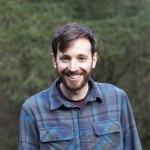 Gideon Mordecai
Gideon Mordecai
Summary: Pacific salmon are vital to the health of North America’s west coast. However, there are major concerns over declining Sockeye and Chinook populations and the expansion of aquaculture in the region. Factors impacting salmon populations are multi-faceted and complex, but accumulating evidence suggests that viruses, which infect all domains of life, could be a key contributor to the collapse of wild salmon.
My research considers the ecology of viruses, i.e.,their interactions with each other, their hosts, and the environment. For my Liber Ero project, I will focus on the transmission dynamics of two recently discovered novel viruses which infect Chinook and Sockeye salmon. One of these viruses is associated with salmon enhancement hatcheries whilst the other was discovered in aquaculture fish.
Viral mutation rates are high. This means viruses quickly accumulate genetic differences during outbreaks. These mutations make it possible to use viral genome sequencing to understand the origin and dispersal of viruses sampled from different populations. Overall, my research will (i) inform knowledge gaps regarding disease transmission between wild and cultured fish; and (ii) provide crucial information on the risks posed by two novel viruses on Sockeye and Chinook salmon, which are species of high conservation concern.
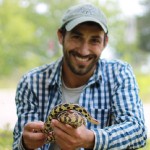 James Paterson
James Paterson
Summary: Habitat loss and road mortality are the greatest immediate threats to reptiles and amphibians in Canada, where the Committee on the Status of Endangered Wildlife in Canada (COSEWIC) estimates that the majority of evaluated reptiles and amphibians are at risk of extirpation.Notably, southern Ontario has more than 37,500 km of roads and has lost more than 70% of its wetlands since colonial settlement. These threats increase the risk of extinction for Ontario reptiles and amphibians.In my Liber Ero fellowship, I will test how roads and habitat loss affect local extinction risk of reptiles and amphibians in southern Ontario, where both biodiversity and human impacts are very high. To accomplish this, I will:
- Combine a large citizen science database from Ontario Nature with historical changes in land use to build occupancy models.
- Use field data on species’ abundance in a heavily developed, but biodiverse protected area.
- Use simulations to test how future combinations of road density and habitat loss are predicted to affect local extinction risks of reptiles and amphibians.
Through my research, I will identify areas at risk of local extinction for reptiles and amphibians from further road development or habitat loss and prioritize areas for conservation action. Furthermore, the occupancy models I develop will provide some of the first estimates of population trends for many reptiles and amphibians in Ontario that can inform future species assessments.
 Dana Reiter
Dana Reiter
Summary: Climate change is creating significant environmental, agricultural and conservation challenges. Concurrently, agricultural producers are tasked with meeting the needs of a growing population in an environmentally sustainable manner while also contributing to biodiversity conservation. To address these challenges, Environment and Climate Change Canada introduced the Species at Risk Partnerships on Agricultural Lands (SARPAL) initiative in 2015, which works with farmers to support the recovery of species at risk on agricultural land. My research will evaluate the effectiveness of the SARPAL program from the producers’ perspective. Including both SARPAL program participants and non-participants, I will survey and interview cattle producers in the interior rangelands of BC, Alberta, Saskatchewan and Manitoba. Furthermore, through expert consultation and using key indicators (e.g., from Canada’s Species at Risk ActRecovery Strategies and Action Plans), I will assess the impacts of SARPAL on habitat outcomes (conservation and restoration). Through my Liber Ero project, I will identify opportunities to improve management practices that achieve multiple goals of species at risk conservation, climate change adaptation, and agricultural production and sustainability.
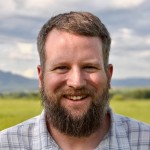 Matthew Williamson
Matthew Williamson
2018 Liber Ero Fellows
 Sean Godwin
Sean Godwin
Summary: The rapid global expansion of aquaculture – the “blue revolution” – is meant to offset our stagnating wild-capture fisheries and feed the world’s growing human population. In some places, the introduction of aquaculture may be contributing to the recovery of previously over-exploited marine ecosystems, but in Canada, the industry has been plagued with controversy. Salmon farming in Canada has been blamed for depleting wild salmon stocks through pathogens and parasites that transfer between farmed and wild salmon, with parasitic sea lice being a primary concern. Together with my project partners, I will put this hypothesis to the test by experimentally determining whether treating juveniles to protect them from sea lice infections can improve adult Pacific salmon returns in British Columbia. For my Liber Ero research, I will also model the population dynamics of wild salmon to evaluate the coastwide relationships between wild salmon populations and salmon farming over the past several decades. With both the provincial and federal governments currently developing their plans for the future of Canadian aquaculture, this research may come at a critical time for the declining populations of wild salmon that are so integral to North America’s coastal economies, ecologies, and Indigenous cultures.
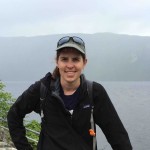 Elizabeth Gow
Elizabeth Gow
Summary: Canadians love birds and cats. But cats kill an estimated 100–350 million birds annually in Canada, and specific to human activities, cats are considered to be the number one killer of birds in Canada. Framing cats as the enemy, however, has many Canadians feeling that conservationists are attacking their valued family pets with little concern for cat welfare. Meanwhile, cat overpopulation is harming cats by contributing to unnecessary disease transmission, illness, injury, and death of cats.Given the influence that cats have on wild bird populations we desperately need data-driven solutions. I aim to develop conservation solutions that help birds, cats, and people by working with my mentor team to develop improved cat and bird management plans. I will use (i) GPS tracking of cats and video cameras on cats to assess how many and what species of birds cats are killing; (ii) trail cameras to assess free-roaming cat populations; and (iii) road kill surveys and veterinary records to develop “heat maps” that identify areas where bird mortality, free-roaming cat populations, and cat mortality are the highest. Collectively these data will help identify the areas where cats pose the biggest threat to birds and where cats may also face the biggest threats. By approaching this complex conservation issue by focusing on what is best for both cats and birds, I envision my research helping conservation efforts by bringing together cat-lovers and bird-lovers so that we can better protect both cats and birds.
 Emma Hodgson
Emma Hodgson
Summary: Human actions across the globe are leading to a suite of changes in marine and freshwater environments. In resource-driven economies like Canada’s, policy and management decisions need to balance the potential community benefits of development with social and ecological risks. It is particularly important that these decisions are made in a way that empowers the Indigenous Peoples of Canada, who often disproportionately experience the negative impacts of industrial development.In my Liber Ero research I will focus on key fisheries resources in two large “working” rivers, where numerous communities rely on migratory fish. In the Skeena River estuary, British Columbia, there is an active conversation underway around how to balance economic opportunities with ecological risk, particularly to Pacific salmon. In collaboration with First Nations groups and the Province of BC, I will review the state of knowledge regarding how estuary changes impact juvenile salmonids. Using a modeling approach, I will also assess population impacts from alternative development scenarios. Separately, in the Peel River, Northwest Territories, whitefish is an important food fish for the Gwich’in peoples of the region. However, this region is experiencing alterations driven by climate change. As well, in the upriver Yukon portion of the Peel specifically, there are risks from potential industrial development. Using a community-based research approach, I will work with local fishers and resource councils to address knowledge gaps in whitefish life history. I will also investigate alterations in migratory and growth patterns of whitefish over the last 40 years to inform our understanding of potential future changes.
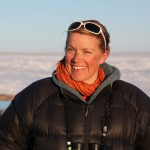 Jennifer Provencher
Jennifer Provencher
2017 Liber Ero Fellows
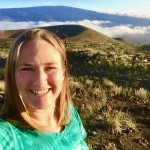 Sarah Joy Bittick
Sarah Joy Bittick
Summary: Canada has vast seagrass ecosystems, yet they are virtually unprotected and experiencing threats associated with accelerating coastal development and climate change—eutrophication, sedimentation, and increased temperature. In British Columbia, there is a long history of community effort to protect seagrass, but little formal legislative action. While federal measures are progressing under the convention on biological diversity (CBD), federal efforts will often miss seagrass, which occurs only at the coastal margins. Local action is necessary to protect seagrass, as individual communities and municipalities act to limit or reduce seagrass-harming actions. My research project will use a bottom-up ecological approach rather than top-down, with the goal of linking the possible negative impact of excessive nutrient input in seagrass beds to trophic use by fish and birds. Using a combination of historical data, nutrient loading models, and experimental approaches, I will work with partners from the City of Surrey to identify threshold levels of nutrient loading tolerated in Boundary Bay seagrass communities for use in water quality management planning. Together with my academic, conservation, and government collaborators, we will use this model in other communities across British Columbia to protect an important resource before habitat degradation becomes irreversible.
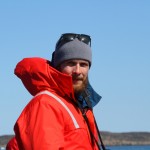 Cody Dey
Cody Dey
Summary: In some areas of the Arctic, polar bears are now being forced ashore each spring due to earlier sea ice melt, and they are increasingly feeding on the eggs of common eider seaducks in lieu of their primary prey, seals. This changing predator-prey relationship has conservation and social consequences – eiders are harvested by many northern people for food and clothing, and increasing polar bear predation could drive declines in eider populations. Additionally, eiders are ecologically important species that link the marine and terrestrial environments. Working with academic and government scientists and Inuit community groups, I aim to create predictive models of changes in common eider population size and spatial ecology in response to changing environmental conditions in the Arctic. These models will require an understanding of the foraging ecology and bioenergetic consequences of nest predation for polar bears, eider population biology and spatial ecology, and patterns of traditional resource use by northern people.
Predicting the effect of environmental change on biodiversity is challenging because each species has complex interactions with other members of their ecological communities. Yet, such predictions are crucial for proactive management of wildlife populations, which is especially important when the species involved are subject to subsistence harvest.
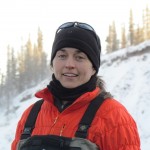 Karen Dunmall
Karen Dunmall
Summary: Biodiversity changes resulting from warming temperatures represent real and imminent conservation challenges that cross geographic boundaries, institutional levels, ecosystems, species, and cultures. My Liber Ero project will use innovative science that combines spatial pattern analyses with genetic seascape analyses to predict aquatic colonizations in the Arctic. I will also develop applied conservation tools, including environmental DNA (eDNA) monitoring, that can be used in a novel citizen science framework to assess those predictions. Salmon, which are potentially colonizing the Arctic fringes of their distributions, are a group of biologically, culturally and economically relevant indicator species that may highlight colonization pathways facilitating northward expansions for other species. My research will build on my experiences leading an established community-based monitoring program, called Arctic Salmon, which monitors generally increasing abundance and widening distribution trends for salmon across the Canadian Arctic. I will integrate cutting edge science with novel community-based monitoring approaches to effectively connect subsistence and science. This approach will transform how distributional shifts of aquatic species are predicted and assessed and will have global applications to conserving and managing fisheries in a rapidly changing Arctic. Follow the research: www.facebook.com/arcticsalmon
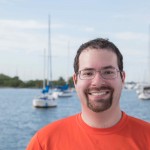 David Shiffman
David Shiffman
Summary: I am an interdisciplinary marine conservation biologist and science communicator with a specialty in shark biology and conservation (follow me on Twitter @WhySharksMatter!). Today, 24% of all known species of sharks and their relatives are threatened with extinction, and overfishing is a leading cause of population declines. There is an ongoing debate in scientific and advocacy circles about whether we should aim for sustainable shark fisheries or ban all shark fisheries. Canada is one of the largest shark fishing nations on Earth by landings and exports. My Liber Ero Fellowship research will focus on the British Columbia spiny dogfish fishery, which was the first shark fishery on Earth to be certified as sustainable by the Marine Stewardship Council, a widely used guide to seafood sustainability. I’ll be looking at what factors influence the sustainability (or lack thereof) of shark fisheries in Canada and around the world using methods from disciplines including fisheries science, ethnography, and media studies. I’ll be determining what makes some shark fisheries sustainable and others unsustainable, with the goal of producing tangible action items for managers and best practices guides for industry. I’ll also be interviewing fishermen and environmental advocates, focusing on gaining a greater understanding of their perspectives on shark conservation and management issues. Finally, I’ll be analyzing media coverage of shark conservation issues to see how the sustainable fisheries vs. banning fishing debate is framed.
2016 Liber Ero Fellows
 Laura Coristine
Laura Coristine
Summary: As a northern country, Canada has high rates of climate change. Distributions for many of Canada’s species are not shifting poleward as rapidly as required due to low levels of landscape connectivity and high rates of climate change. Loss of climatic habitat increases a species’ future extinction risk and species that are already at risk may be particularly vulnerable. In order to manage climate change impacts to biodiversity, Canada will need to prioritize and enhance ecological and climatic connectivity between existing protected areas. Broad-scale planning tools and evidence-based assessments are urgently required by organizations involved in multi-jurisdictional land management across both private and public lands. I aim to develop these tools and assessments so that Canada can integrate conservation policy with issues of climate change. Using a nation-wide macroecological approach, I will (i) evaluate spatial and temporal stability of contemporary climate changes; (ii) investigate how regions with attenuated and exacerbated climate changes alter distribution shifts for species of conservation concern; and (iii) identify strategic configurations of dispersal networks based on connectivity analysis that incorporates climate refugia. Through my research, I seek to inform national, regional and local priorities that address climate change challenges for Canada’s biodiversity.
 Aerin Jacob
Aerin Jacob
 Jeremy Pittman
Jeremy Pittman
Summary: Balancing food production and biodiversity conservation is one of the most challenging, yet necessary, tasks facing humanity. We need to feed a growing global population, while minimizing our impacts to other species. Nowhere is this challenge more apparent than on the Canadian Prairies. Historically modified and persistently occupied by people, Canada’s prairies have been transformed from a vast expanse of continuous grass to a fragmented patchwork of native habitat. This transformation has placed many species at risk and made grasslands conservation a top priority; while at the same time the region has become globally important due to its agriculture sector and the hotbed of a rich rural identity. Any efforts to conserve Canada’s grasslands must acknowledge the hardworking people who earn their living from these landscapes. My postdoctoral research will contribute to such efforts. By employing an innovative and integrated set of tools from the natural and social sciences, I will examine – in a case study from southern Saskatchewan – how patterns of social relationships between people, ecological relationships across landscapes, and social-ecological relationships between people and their landscapes influence conservation outcomes. I will endeavour to identify not only the problems associated with the observed patterns of relationships, but also strategies to leverage these patterns that will enhance conservation and improve the wellbeing of rural people. I feel incredibly fortunate to be part of the Liber Ero program, and I look forward to contributing to grassland conservation in Canada.
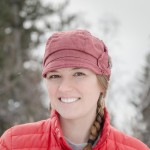 Jean Polfus
Jean Polfus
Summary: Including indigenous people in environmental decision-making is crucial to the implementation of effective conservation actions, but there remains a critical gap in the exchange of information among researchers, managers, policy makers, and indigenous communities. This interface deserves attention because social, cultural, and language barriers are especially pronounced in northern Canada. The lack of effective communication strategies has hindered the success of caribou management plans. In order to find sustainable solutions to the complex management challenges that characterize this culturally and ecologically important species, there is a need to develop a common understanding through transparent and effective communication. My research project will develop, assess, and evaluate innovative cross-cultural methods required to communicate indigenous and scientific knowledge about caribou, among indigenous communities and to other stakeholders, in a clear and compelling manner. By focusing on communication and education, the project will produce a framework for improving public engagement related to ongoing landscape-scale planning processes. The project will innovate adaptive interdisciplinary tools that can be used by researchers and communities to facilitate cooperative long-term problem solving, improve the performance of ongoing research, and raise awareness for management priorities. The project will support real, practical conservation outcomes that reflect diverse ways of knowing and affirm the value of community caribou stewardship.
 Richard Schuster
Richard Schuster
Summary: Alarming declines are currently underway in numerous migratory vertebrate populations, creating an urgent need to understand when and how these populations are limited. My goal for this fellowship is to help improve conservation efforts along the migratory cycle for a suite of bird species breeding in Canada. Specifically, my project will address three questions:
- How abundant are migratory bird species in landscapes that have differing levels of anthropogenic disturbance in breeding and overwintering habitats?
- What is the influence of alternative scenarios of habitat loss and protection over large geographic areas on the population trends of migratory species?
- Which regions are the best candidates for habitat protection, with the goals of maximizing biodiversity protection and minimizing risk of conservation failure?
This project will dramatically advance the development and application of metapopulation models for migratory species over space and time. I will deliver strategic plans that optimize conservation strategies across entire ranges for migratory species and identify portfolios of sites critical to the global persistence of these species. The framework I will develop has great potential to facilitate better-informed and more cost-effective conservation programs, which in turn have a higher likelihood of implementation and success.
2015 Liber Ero Fellows
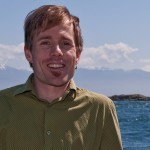 Nathan Bennett
Nathan Bennett
Summary: The Great Bear Sea on the Pacific coast of Canada contains a marine area of 88,000 km2. The ecological, as well as economic and social, importance of the marine environment in the area has motivated significant attention to marine conservation, management and planning in the region. Numerous organizations and actors – including governments, First Nations, NGOs, and foundations – are involved with promoting and facilitating marine conservation and management initiatives on the west coast. My project seeks to survey and document the extent and effectiveness of the network of individuals and organizations involved in marine conservation in the Great Bear Sea to understand where different organizations are working, what actions are occurring across the region, and what progress is being made toward achieving conservation outcomes. Through this conservation social science research project, I aim to enable more effective marine conservation policy and advocacy networks in Canada.
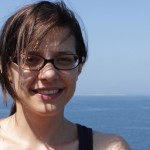 Kimberley Davies
Kimberley Davies
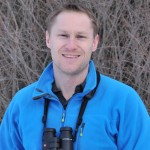 Tyler Flockhart
Tyler Flockhart
 Diane Orihel
Diane Orihel
Summary: Canada’s economy was built on our rich natural resources, but our long-term prosperity rests on developing resources responsibly. To do so, we need to match the pace of economic growth with advances in environmental protection.By partnering with the University of Ottawa’s Centre for Advanced Research in Environmental Genomics, I seek to create sensitive new tools for performing medical check-ups on Canada’s frogs. Frogs are sensitive creatures—like the canary in a coal mine, frogs provide an early warning system for problems with the health of the environment, and even our own health.
Some chemicals, such as those produced through mining of oil sands, are suspected of disrupting the hormone system of animals. Because the transformation of tadpoles into frogs is tightly controlled by hormones, exposure to hormone-disrupting contaminants may impair normal frog development.
My research will take a magnifying glass to the genetic information hidden within the cells of frogs in the hope of finding the keys to these developmental defects. This may lead to the discovery of innovative techniques for assessing the well-being of frogs and other amphibians in polluted ecosystems.
2014 Liber Ero Fellows
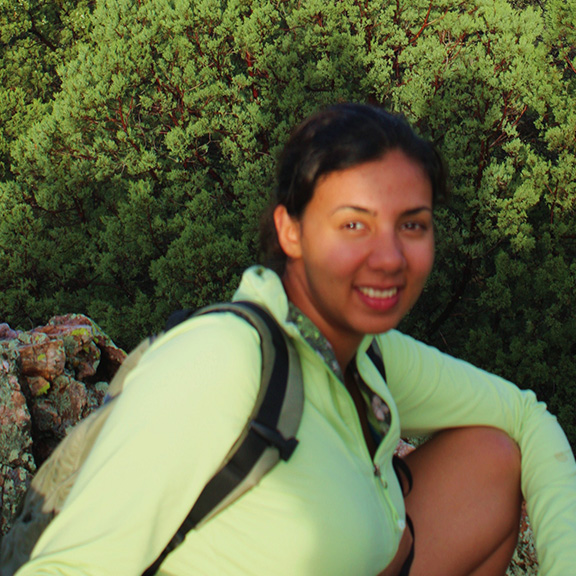 Sheila Colla
Sheila Colla
Summary: Bee declines have recently emerged as a serious threat in Canada and globally. While the introduced European Honeybee has garnered much public attention, increasing evidence suggests some of Canada’s native bee species are also experiencing declines in abundance and distribution. In fact, the Rusty-patched Bumblebee was a previously common species in southern Ontario as recently as the early 1990s and my PhD work showed it has since declined to the point of extreme rarity. Despite targeted searches over the past 10 years, only a handful of individuals have been found, resulting in its assessment to be ‘Endangered’ federally and provincially. Causes of native bee declines are largely speculative and untested but likely involve introduced pathogens, pesticide use, habitat loss, climate change and/or competition with invading species. My project builds on current collaborative efforts to accomplish the following:
- Initiate captive breeding, reintroduction and/or translocation programs for declining bumblebee species.
- Work with landowners to create long-term habitat designed to support species at-risk. Assess suitability and success of habitat restoration/creation.
- Investigate the effects of global change and gather natural history information using high quality, long term data on bumblebee abundance and distribution.
- Test the hypothesis that declining bumblebee species are more susceptible to pathogens and explore possible synergistic effects with other threats.
 Adam T Ford
Adam T Ford
Summary: Corridors have long been suggested as a means to prevent habitat loss and fragmentation from having a negative effect on wildlife populations. Despite their widespread and growing use in conservation efforts around the world, it is not clear what factors contribute towards the design of an effective wildlife corridor – especially for large mammals. My project will help fill this knowledge gap by linking recent advances in movement ecology with a mechanistic approach to quantifying corridor functionality for an assemblage of large mammals in the Canadian Rockies. Specifically, my project will address three questions:
- What design features of corridors increase the likelihood of use by wildlife?
- To what extent does animal behaviour affect optimal corridor design?
- Can selected focal species serve as surrogates or indicators of connectivity for other species?
This project integrates with the efforts of federal, provincial and conservation agencies working in the Rocky Mountains to minimize human-wildlife conflicts in an increasingly fragmented landscape.
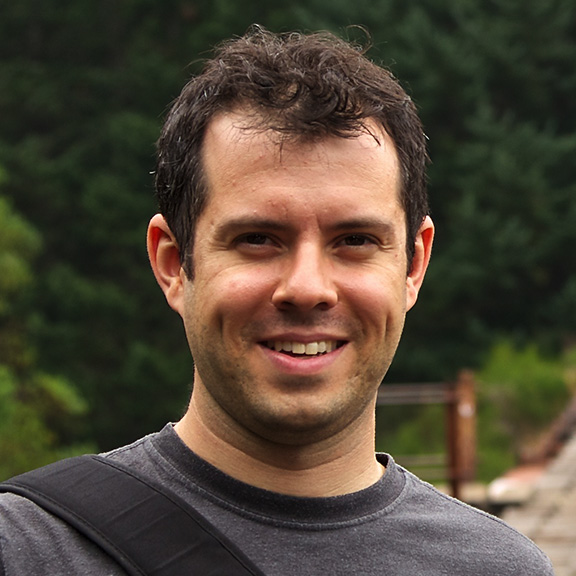 Eduardo Martins
Eduardo Martins
Summary: In the past 20 years, there have been large declines in the abundance of many Fraser River sockeye salmon stocks. Such declines coupled with the unexpectedly low sockeye salmon returns in 2009 prompted a $26M federal judicial inquiry. My project will address one of the key recommendations of the inquiry: to develop a generalized framework to assess the cumulative effects of stressors on Fraser River sockeye salmon. Using data sets being collected by Fisheries and Oceans Canada over the past 50 years, I will: (1) conduct a detailed analysis of the cumulative effects of stressors on survival and fecundity of Fraser River sockeye salmon; (2) use stage-structured population models to assess the dynamics and viability of populations experiencing multiple stressors; (3) use the model framework to quantify the impact of specific stressors; and (4) assess the efficacy of potential management actions in reducing the impacts. My research will generate invaluable results and tools to assess how the impacts of cumulative stressors and management actions will influence the future sustainability of Fraser River sockeye salmon.
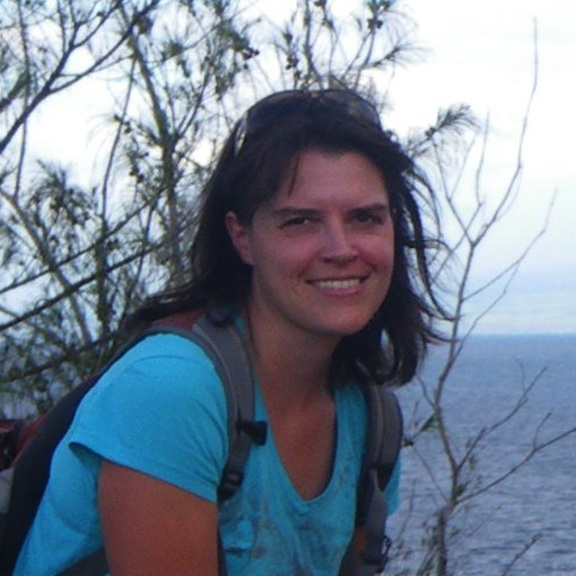 Jenny McCune
Jenny McCune
Summary: Over 90% of southern Ontario was originally forested, but by 1920 less than 10% of these vast forests remained. The loss and fragmentation of forests contributed to the extinction or decline of many species, including hundreds of forest-dwelling plants. In many cases, we lack the basic data on current population sizes and locations of rare plant species needed to determine whether or not they can survive in such a highly fragmented system. In addition, most of southern Ontario’s forest remnants are privately owned, but many landowners aren’t aware of rare forest plants. My goal is to help streamline rare plant surveys by targeting areas with the most suitable habitat, and to increase public awareness of these remarkable plants. To do this, I will build species distribution models for a subset of rare forest plants by combining known locations of each species with fine-grained topographic, climatic and geological data. I will use these models to prioritize woodlands for rare plant surveys. I will also create an informative fact sheet for each species to use during visits with landowners, and make these information sheets available via the websites of conservation organizations and woodlot landowner associations.
2013 Liber Ero Fellows
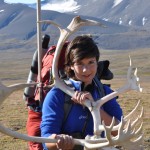 Anja Carlsson
Anja Carlsson
 Christina Davy
Christina Davy
Summary: In 2006 a novel fungal pathogen (Geomyces destructans) emerged in a bat hibernaculum near Albany, New York. The white, cottony patches on the muzzle, ears and wings of infected, hibernating bats led biologists to name the disease “white-nose syndrome” (WNS). Over 5.7 million bats are thought to have died from WNS since 2006, which represents the fastest decline of wild mammals ever documented and threatens previously common species such as the Little Brown Myotis (Myotis lucifugus) with extinction. This conservation crisis is being tackled through extensive collaborations among academia, governments and NGOs. My project targets the following specific priority research gaps identified in the Canadian National Management plan for bats and WNS, and by the Canadian Interagency WNS Committee:
- Determine gene flow and population structure of bats in Canada to better understand the movement of WNS between populations and across the landscape
- Investigate species and population differences in pathogenesis and susceptibility
- Investigate proteomic and functional genomic responses of bats to WNSMy objective is to address some of these knowledge gaps in ways that complement other, ongoing projects, to provide a unique perspective on mitigation of WNS and conservation of bats in the Canadian context.
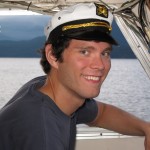 Brett Favaro
Brett Favaro
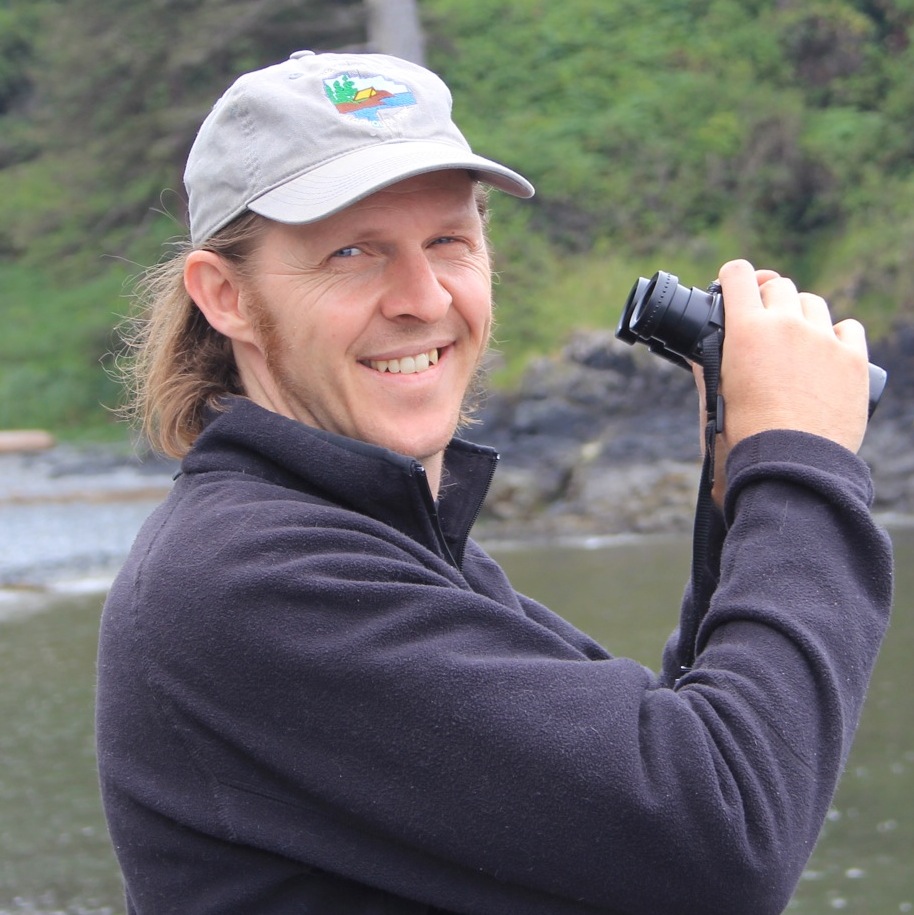 Kevin Fraser
Kevin Fraser
declining songbirds.


